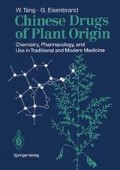Abstract
Shengma, Rhizoma Cimicifugae, is the dry rootstoek of Cimicifuga heracleifolia Kom., C. dahurica (Turcz.) Maxim. or C. foetida L. (Ranunculaceae) which is collected in the fall. This officially listed traditional Chinese medicine is used as an antipyretic and analgesic.
Access this chapter
Tax calculation will be finalised at checkout
Purchases are for personal use only
References
Muravev IA, Vasilenko YK, Basharov AY, Parfenteva EP, Skulte IV (1985) Hypolipidemic properties of cimicilen, isolated from Cimicifuga dahurica (Turcz.) Maxim. Farmatsiya (Moscow) 34:38–42 (CA 103:206007m)
Sakurai N, Inoue T, Nagai M (1972) Chinese crude drug shoma. II. Triterpenes of Cimicifuga dahurica. Yakugaku Zasshi 92:724–728
Kumura O, Sakurai N, Nagai M, Inoue T (1982) Studies on the Chinese crude drug “Shoma”. VI. Shengmanol xyloside, a new genuine natural product of some Cimicifuga glycosides. Yakugaku Zasshi 102:538–545
Kimura O, Sakurai N, Inoue T (1983) Studies on the Chinese crude drug shoma. VII. Isolation and determination of genuine natural products, acetylshengmanol xyloside, 24-O-acetylhy-droshengmanol xyloside and shengmanol xyloside in Cimicifuga dahurica and the other Cimicifuga plants. Yakugaku Zasshi 103:293–299
Inoue T, Nakata C, Izawa K (1970) Chinese crude drug shoma. I. Isolation of phenolic carboxylic acids from the rhizomes of Cimicifuga dahurica and Cimicifuga simplex. Shoyakugaku Zasshi 24:76–80
Ito M, Kondo Y, Takemoto T (1976) Studies on the constituents of Cimicifuga spp. X. Spasmolytic substances from Cimicifuga dahurica Maxim. Chem Pharm Bull (Tokyo) 24:580–583
Hata K, Baba K, Kozawa M (1978) The structure of the yellow pigment from the rhizomes of Cimicifuga dahurica Maxim. Chem Pharm Bull (Tokyo) 26:2279–2280
Baba K, Kozawa M, Hata K, Ishida T, Inoue M (1981) The structure of yellow pigments from the rhizomes of Cimicifuga dahurica. Maxim. Chem Pharm Bull (Tokyo) 29:2182–2187
Yamahara J, Kobayashi M, Kimura H, Miki K, Kozuka M, Sawada K, Fujimura H (1985) Biologically active principles of crude drugs. The effect of Cimicifugae Rhizoma and its constituents in preventive action of the carbon tetrachloride-induced liver disorder in mice. Shoyakugaku Zasshi 39:80–84
Author information
Authors and Affiliations
Rights and permissions
Copyright information
© 1992 Springer-Verlag Berlin Heidelberg
About this chapter
Cite this chapter
Tang, W., Eisenbrand, G. (1992). Cimicifuga dahurica (Turcz.) Maxim.. In: Chinese Drugs of Plant Origin. Springer, Berlin, Heidelberg. https://doi.org/10.1007/978-3-642-73739-8_41
Download citation
DOI: https://doi.org/10.1007/978-3-642-73739-8_41
Publisher Name: Springer, Berlin, Heidelberg
Print ISBN: 978-3-642-73741-1
Online ISBN: 978-3-642-73739-8
eBook Packages: Springer Book Archive

